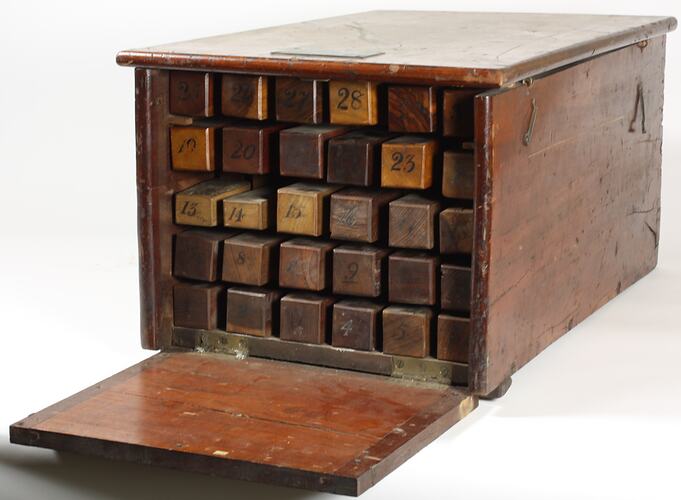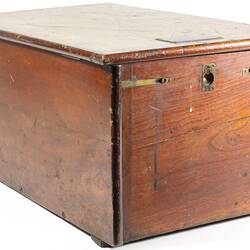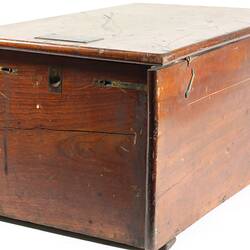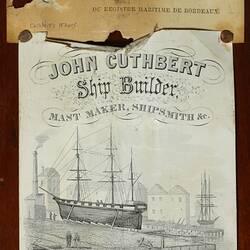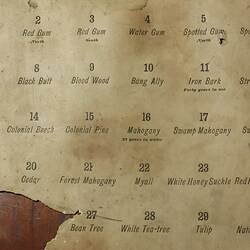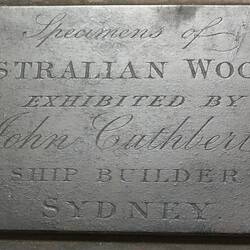Summary
Box of Australian timber samples exhibited by John Cuthbert, Ship Builder of Sydney in the New South Wales Court at the 1866 Intercolonial Exhibition in Melbourne. The box contains 30 timber samples from blue gum, northern red gum, southern red gum, water gum, southern spotted gum, northern spotted gum, iron bark, black butt, blood wood, bang ally, iron bark (40 years in use), stringy bark, mangrove, colonial beech, colonial pine, mahogany (27 years in water), swamp mahogany, swamp oak, kauri pine, cedar, forest mahogany, myall, white honeysuckle, red honeysuckle, bean tree, white tea-tree, tulip and native pear tree.
John Cuthbert (1815 - 1874) was born in Ireland and arrived in Australia in 1844. Between 1855-1874 he operated his ship building business based at Miller's Point in Sydney. He designed and built Australia's first warship, the 'Spitfire', from ironbark and black butt timbers with copper fastenings. The ship was commissioned by the New South Wales colonial government and was launched on the 4th April 1855.
The Intercolonial Exhibition of Australasia was held on the site of the Public Library, in new wings that eventually became the site of the Industrial and Technology Museum in 1870, a forerunner to the National Museum of Victoria. The Exhibition covered 56,240 ft. The majority of the 2,956 exhibitors were Victorian, but the other Australian states also contributed significantly; displays were also mounted by exhibitors from New Zealand, New Caledonia, Netherlands-India and Mauritius. The Exhibition opened on 24 October 1866 and closed on 23 February 1867. A total of 268,634 people attended.
Physical Description
The box is rectangular, scratched and made from a dark-stained timber. It has a hinged lid with two swivel metal latches on the front that clasp the two hooks that are fitted to the edge of the lid. The lid does not sit flat and cannot be latched. On one side of the lid there is a metal label with stamped/engraved text. There is a hinged side wall that opens out and down to allow access to the samples. Inside this side wall there is a small ITM sticker attached with a number. There is a ring fitting (broken) latch on this side wall. The 30 samples are arranged 6 wide by 5 deep and are separated by crossed timber slats so that each sample can be individually removed. Each sample is polished and has a number written on one of the square faced ends. There is a loose sheet of paper inside the box printed with the numbers and names of the samples. The bottom left hand corner is torn and missing, leaving samples 25 and 26 unidentified. There is pencil writing on the ends of these two samples but it is illegible. There are two pieces of paper/card (possibly business cards) attached with tacks to the inside of the lid. There is also a scrap of faded ribbon with orange staining.
More Information
-
Collecting Areas
-
Place & Date Exhibited
Exhibition: 1866 Intercolonial, Melbourne, Melbourne, Victoria, Australia, 1866
-
Inscriptions
On metal label:" Specimens of / AUSTRALIAN WOODS / EXHIBITED BY / John Cuthbert / SHIP BUILDER / SYDNEY" On ITM sticker:"10907" Printed on smaller paper card: " JOHN CUTHBERT / Constructeur Expert. / DU REGISTRE MARITIME DE BORDEAUX / Cuthbert's Wharf" Printed on larger paper card:" JOHN CUTHBERT / Ship Builder / MAST MAKER SHIPSMITH Etc / [drawing of a three-masted sailing ship at a dock] / PATENT SLIP KING STREET, DARLING HARBOUR / Dry Dock / Cuthbert's Wharf, Miller's Point / SYDNEY" On sheet of paper:"1 / Blue Gum", "2 / Red Gum / North", "3 / Red Gum / South", "4 / Water Gum", "5 / Spotted Gum / North", "6 / Spotted Gum / South", "7 / Iron Bark", "8 / Black Butt", "9 / Blood Wood", "10 / Bang Ally", "11 / Iron Bark / Forty years in use", "12 / Stringy Bark", "13 / Mangrove", "14 / Colonial Beech", "15 / Colonial Pine", "16 / Mahogany / 27 years in water", "17 / Swamp Mahogany", "18 / Swamp Oak", "19 / Kauri Pine", "20 / Cedar", "21 / Forest Mahogany", "22 / Myall", "23 / White Honey Suckle", "24 / Red Honey Suckle", "27 / Bean Tree", "28 / White Tea-tree", "29 / Tulip", "30 / Native Pear-tree"
-
Classification
-
Category
-
Discipline
-
Type of item
-
overall dimensions
700 mm (Width), 420 mm (Depth), 340 mm (Height)
Dimensions above are for the external box. Sample dimensions are an average of 49 mm wide x 47 mm height x 607 mm long.
-
References
Biography of John Cuthbert [Link 1] - Retrieved 17 Jun 2010 John Cuthbert built Australia's first warship: [Link 2] - Retrieved 17 Jun 2010 1855 'LAUNCH OF THE FIRST AUSTRALIAN GUNBOAT.', Empire (Sydney, NSW : 1850 - 1875), 5 April, p. 4, [Link 3] - Retrieved 18/3/2014. Description of Display at Intercolonial Exhibition Melbourne: Newspaper article (The Argus, 25 Oct 1866, p.6) [Link 4] - Retrieved 29-7-2010
[Manuscript] Hobbs, Roger. Timbers, Planks and Keels: A Type Profile.
[Book] Hobbs, Roger. 2017. A Shipwright in the Colonies, John Cuthbert 1815-1874.
-
Keywords
Australian Timbers, Economic Botany, Eucalypts, Exhibitions: Melbourne Intercolonial, Australasian, 1866-1867, Shipbuilding, Timber Samples
